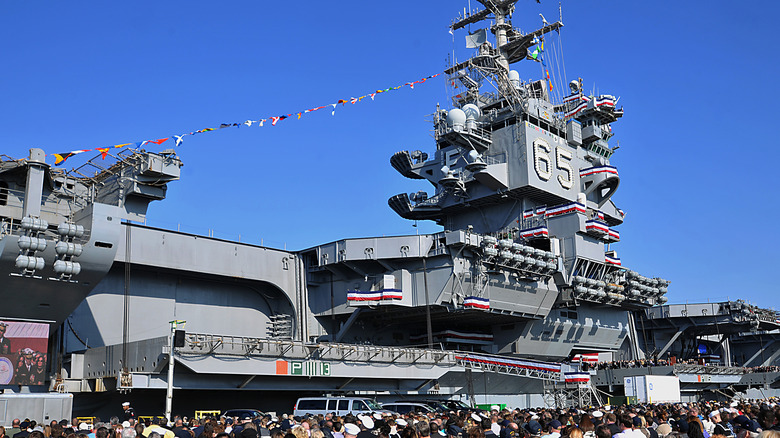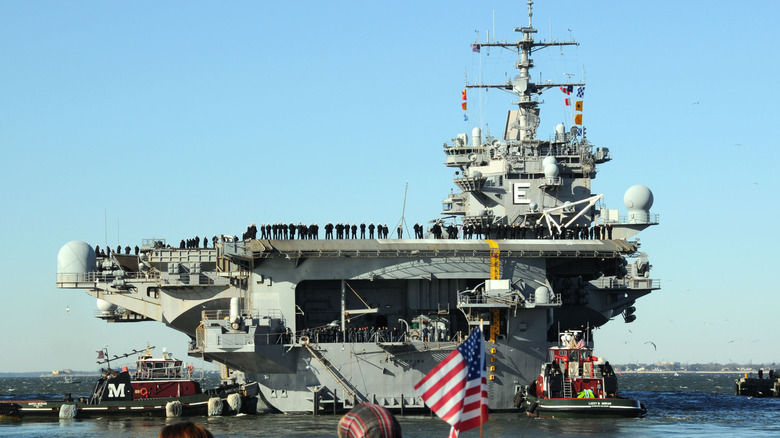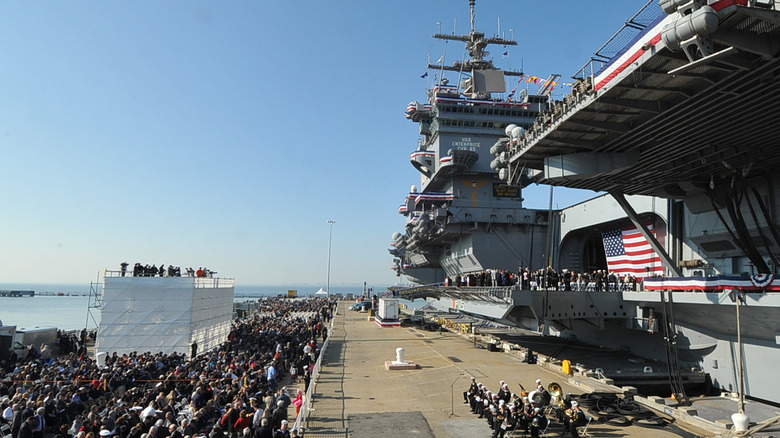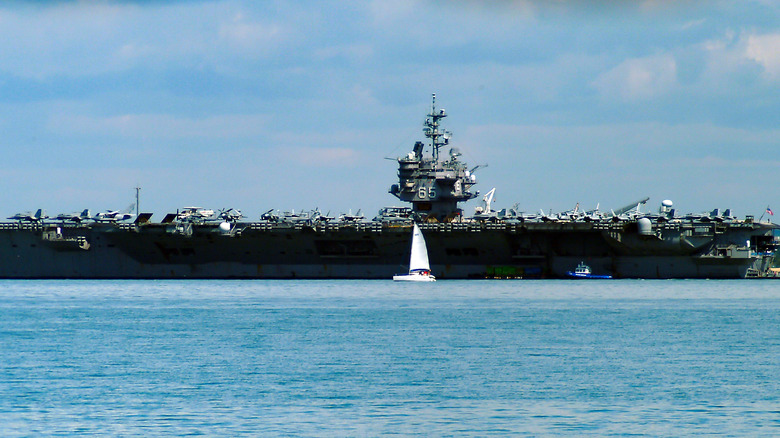Everything You Need To Know About USS Enterprise, America's First Nuclear-Powered Carrier
Even though aircraft carriers have been around for decades, many can't help but marvel at the unimaginable vastness of the vessels. They are floating military cities that can park off the coast of enemy territory and help change the course of a war with relentless payloads, and yet are swift enough to circumnavigate the globe for extended periods of time without needing to stop to refuel. Perhaps no carrier embodies this more than the USS Enterprise. As America's first nuclear-powered carrier, the USS Enterprise (CVN-65) seemed to set the mold for all carriers that came after it with a legacy and durability that spanned multiple decades.
It played a pivotal role in nearly every major U.S. wartime effort for the past 50 years, including participating in the blockade of Cuba during the Cuban Missile Crisis, air operations off Vietnam, as well as some of the first air missions in Afghanistan. But its sheer magnitude is what people tend to notice offhand.
The USS Enterprise size and specs
The dimensions speak for themselves: A hangar bay with five acres of space spanning 1,123 feet, and eight nuclear reactors (to power its four giant propellers), all of which produced 280,000 shaft horsepower to a speed upwards of thirty-five knots, which it could sustain for more than 20 years without needing to refuel. It did all this while displacing about 93,284 tons of water fully loaded and carrying around 85 aircraft and 5,500 crew. They might not all fit on the flight deck at the same time, but it's possible, considering that the deck was 1,101 by 252 feet.
Those immense dimensions were matched by a service record just as lengthy. Over the course of its 51 years in service, the USS Enterprise participated in 10 major operations, conducted 25 deployments, shouldered 400,000 arrested landings, and saw over 100,000 veterans serve aboard. To say it was self-sustaining is an understatement, but its power and island-like size helped tip the balance in numerous conflicts.
CVN-65's storied role in multiple conflicts
Commissioned in Virginia in 1961, the USS Enterprise began its career in 1962 not by assisting with anything ocean-related but instead by helping out with space. That's because its orders involved tracking and measuring the flight of the first American orbital spaceflight, Friendship 7, during the Project Mercury Program.
According to the National Museum of the U.S. Navy, soon after, it deployed as part of a blockade during the Cuban Missile Crisis. Two years later, it joined up with the missile cruiser USS Long Beach (CGN-9) and missile destroyer USS Bainbridge (DLGN-25) to participate in Operation Sea Orbit. The three ships circumnavigated the globe in 65 days while traveling a total of 30,565 miles, a feat that demonstrated what a nuclear-powered fleet is truly capable of.
Heavy action continued when it later took part in the Vietnam War by launching aircraft against the Viet Cong and North Vietnamese targets and wound up conducting a total of six cruises off Vietnam. Even with all the action it saw, one of the worst days it suffered came in 1969 as a result of an accident that occurred while conducting operations off Hawaii when a rocket exploded on the flight deck. The explosion set off nine bombs, ultimately injuring 343 people, killing 28 crewmen, and destroying 15 aircraft.
A storied legacy comes to an end
After Vietnam, the USS Enterprise saw less conflict, but was used in 1988 as part of Operation Praying Mantis in the Persian Gulf. It also enforced no-fly zones over Bosnia and Iraq in the 1990s and saw combat in Iraq during Operation Desert Fox and in Afghanistan in Operation Enduring Freedom.
It was finally retired in 2012 while returning to its homeport in Norfolk, Virginia. Building a nuclear-powered aircraft carrier is obviously no easy feat, and taking apart the Enterprise can certainly be as complicated, especially since nuclear waste is involved. After considering numerous consultations, the Department of Defense plans to transport the ship to a contractor, where it will be fully taken apart, with certain parts to be recycled where possible.
As for the reactors, they'll be split into small pieces in several hundred containers and transported and disposed of according to regulations. It may be a slightly anti-climactic end for such a storied vessel, but it won't be for the namesake, as the Navy has named nine ships the Enterprise since 1775, with the latest planned (CVN-80) to enter service in 2029.



